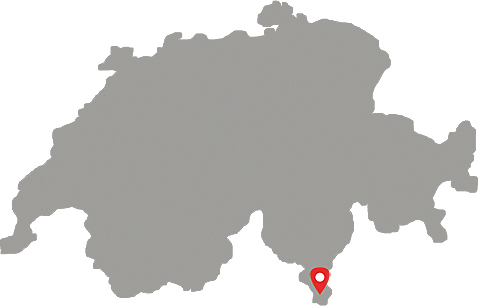Ticino, Switzerland’s southernmost, Italian-speaking region, is somewhat out on a limb, geographically, linguistically – and even viticulturally. On the map, it looks as though you could easily nip up over from Graubünden, via the San Bernardino Pass. It also seems like it’s right next door to the Valais – except for the matter of more mountains, some pretty daunting passes and/or the occasional tunnel. Officially Italian, Switzerland’s third language, is spoken, though you will hear almost as much German and Swiss-German. And from a vinous point of view, in contrast to the multitude of grape varieties Swiss growers in other regions have at their disposal, Ticino is 90 percent Merlot-land.
The most obvious way to reach Ticino from parts north is to come down through the Gotthard Tunnel, building in extra time in case of the legendary summer and holiday weekend road blocks. Whichever way you get here, it’s always a shock when you emerge from the tunnel, after the groomed shores of Lake Luzern. The southern side of the Alps is so dramatic, rugged and fierce that it feels like – and to a certain extent is – another country.
Keep your eyes skinned as you exit the tunnel for the first signs of winegrowing. Even in these wild little corners you’ll catch glimpses of patchworked vineyards clinging precariously to steep terraces called ronchi. It’s up here around Giornico and Bodio that the old-established house of Gialdi has traditionally sourced its grapes, buying from around 300 contracted vinegrowers whose granite and gneiss-based vineyards are scattered throughout the Tre Valli region of the Sopraceneri, the northern half of the canton.
The other half of this huge concern – they make around one million bottles annually – is Brivio, founded in the 1980s by Guido Brivio, who formerly owned the concession for Cynar, the artichoke-based aperitif. These two grand houses have been joined at the hip since 2000, but the Gialdi and Brivio lines retain separate identities and the wines are quite distinct. As star winemaker Alfred de Martin explains, this is down to several different elements: firstly, the different terroirs in which the grapes are grown, the two different climates and the type of oak barrel used for ageing the wines. In the north, where most of the Gialdi grapes are sourced, the granite and gneiss-based soils are more acid, there’s a noticeable difference between day and night-time temperatures and a lot less rain. The resulting wines are more mineral and tannic – put very simply, their style is more that of Bordeaux. Brivio grapes come mainly from the southern part of the canton, the Sottoceneri, where soils are richer and heavier and the rainfall higher. To the surprise of many, for whom Ticino conjures up visions of palm-fringed lakes and parasols, the region gets about three times as much rain annually as its neighbour to the west, the Valais. Brivio wines, says Alfred, are made more in a Burgundy style (albeit from different grapes), somewhat softer and rounder.
As is the rule in Ticino, Gialdi and Brivio work almost exclusively with Merlot, the great majority of it red and oak-aged. But Merlot (like Pinot Noir) is a black grape with white juice, so in an original twist – and in response to the region’s need for a local white wine – they make some white Merlot. Taste the Gialdi Terre Alte alongside the Brivio Bianco Rovere and you can see clearly the difference in the two styles: the first is water-pale, straight and simple, reflecting its more austere, northerly terroir. The second, with a smoky-oaky nose (from some new oak) is a rich mouthful from the richer, clay terroir, good with robustly flavoured food. There’s also a pretty, wild raspberry-coloured, unoaked Brivio rosé which was a proud prizewinner in the 2015 Mondial du Merlot.
For the rest, it’s a steady crescendo up the Merlot ladder, from Bordeaux-inspired blends like Brivio’s fresh, nicely acidic Vigna d’Antan via the mouthfilling, monovarietal, old-vine Riflessi d’Epoca up to the high-class, all-Merlot Sassi Grossi and Platinum, both of which have covered themselves in glory in both Swiss and international competitions.
A high point of any visit to the winery in Mendrisio is provided by the cantine mendrisiensi, a series of dramatic, naturally ventilated, barrel-vaulted cellars carved out beneath the Monte Generoso mountain, where serried ranks of French oak barrels slumber for months or years till ready for bottling.
These are elevated wines by any standards, which appear on the wine lists of Switzerland’s top restaurants and in select wine shops and which provide many a talking point (Parker points too). To bring me back down to earth, I left with the wise words of winemaker Alfred de Martin ringing in my ears: “Sometimes we talk too much about wine and we don’t just get on with drinking it. The biggest compliment to me is when people just want to finish the bottle!”


|
ADDRESS: Via Vignoo 3 6850 Mendrisio CONTACT: Tel. 091 640 30 30 |
WINES TO LOOK OUT FOR: Terre Alti Merlot Bianco Bianco Rovere Merlot Vigna d’Antan Merlot Riflessi d’Epoca Merlot Sassi Grossi Merlot Platinum |
|
Price range 14 to 93 SFr. |
|
|
HIGHLIGHTS: Wines are available online and from their Vinoteca wine shop open Monday to Friday, from 8–12 and 1.30–5.45; Saturdays from 9–12.45. |
|